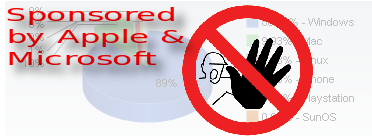

AS SEVERAL readers have stated, there is a lot of anti-GNU/Linux venom in the press these days. A lot of it is reliant upon lies, which if repeated frequently enough, obviously become true in the minds of the less prudent observers.
I wrote to Net Applications on May 6, with the operative part of my query being: "Can you please elaborate as to the methodology employed to obtain these statistics and the geographical regions which are covered? I searched your site for information but could not find anything."
Back came an automated reply which gave me reason for hope; it said, among a host of other things, "Messages are normally answered within 24 hours on weekdays." But that was the end of the matter. A week later I am none the wiser as to how the statistics were collected and what geographical area they cover.
[...]
If one wants to look at anything other than the statistics as provided by Net Applications, one has to subscribe to something called "Geolocation Upgrade" and pay - the options cost anything from $US300 to $US1000.
But on that page, one does get an indication of the reach of the statistics. One option available is geolocation segmentation - "country, region, designated market area, city and postal code and combination reports for browsers, operating systems and search engines." And it adds: "Postal code segmentation is for the US, UK and Canada only."
Another option, titled demographic upgrade, is available for the US only. No mention of China, India or Brazil, three rather large countries where sizeable numbers of the six billion humans who populate our world live.
It is surprising that nobody has thought to ask these questions - it doesn't take much intelligence to do so. There has been considerable angst among some at what they call under-reporting of the degree of Linux take-up on the desktop.
You may have seen that, according to NetApps Linux is used by 1% (or in words - one percent) of online users. There’s one thing to note, and that is the fact that not all Linux users are using it to surf, and that some are changing their user agent strings to mimic IE on Windows. The other, probably more important thing is that NetApps base their studies mostly on surfers from US of A.
With Folk Like This GNU/Linux Needs No Enemies
[...]
Since I am no longer fond of Microsoft products and have never been fond of Apple much I wondered how Kim handles questions about GNU/Linux a.k.a. Linux. Some searches on her site point to Linux questions that are only covered under her premium content. While I am curious how Kim answers these questions I am not curious enough to pay to find out. I also did some web searching with AltaVista and found that Kim has a regular column in the Gannett owned USA Today. Her last column there that had Linux in the title was in 2003. I read the column and discovered the typical “Linux is a command-line OS”, which it is not, and “GNU/Linux is only for tinkerers”, meaning geeks, information.
[...]
There are more “experts” like Kim out there on the WWW that make their living off of Microsoft created problems. For the most part they all denigrate adoption of GNU/Linux by average desktop PC users. After all, these “experts” are invested in Microsoft as their cash cow and do not want to kill that beast. I understand their motivation to keep people on Microsoft products even though I find this motivation repugnant. GNU/Linux is definitely ready to be used by average users buying preloaded desktop systems. The typical Microsoft “expert” is just not ready for GNU/Linux it seems.
--Paul DeGroot, a Directions On Microsoft analyst
Comments
amd-linux
2009-05-14 18:07:11
The thing is that NetApps gets a lot of attention from US/UK IT press, while other observations that show MUCH higher numbers and are equally representative are more or less ignored.
One example is OS stats on heise.de, which is THE mainstream IT new site in Germany. They have now 15% Linux users among their readers, and it would be way more if readers like me were in a situation to use Linux in the office where I read heise.de mostly.
Another example, if you question heise.de being representative is spigel.de which is one of the leading sites of the world (133 in Alexa) and a mainstream news website. Here Linux has around 4%-6%, coming from nearly nothing 2 yrs ago. While spiegel.de is a German news site, is is read from around the world like the BBC site.
It is IMHO safe to assume that Linux worldwide is closer to 2 % than to 1%. The only source who could reliably shed some light on this would be Google, but they refuse to publish any numbers.
But the best, and this nobody can ignore, is the trend. Linux usage is virtually exploding with growth in the double digit percentage area quarter per quarter.
Gentoo User
2009-05-14 20:57:35
But claiming that their metrics are a result of being in Microsoft's pockets, implying yet-another-evil-deed, referring back to more opinions passed as flawed "analysis", claiming you have a gut feeling that they're wrong and cleverly pasting in off-context quotes by the alleged minions of Satan is not the way to go about making your point. Ignoring obvious logical holes in your claims isn't, either.
This type of deeply flawed toxic advocacy (and I'm referring in general to most of what is put forth on this blog) does far more damage than Microsoft could ever hope to afflict the FOSS community with.
Gentoo User
2009-05-14 17:15:21